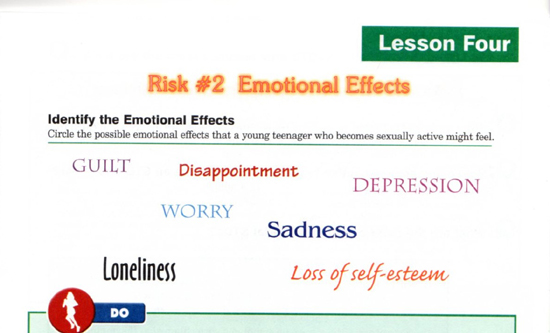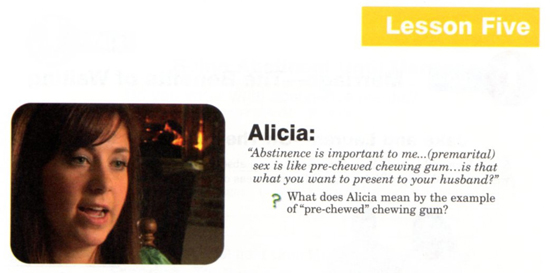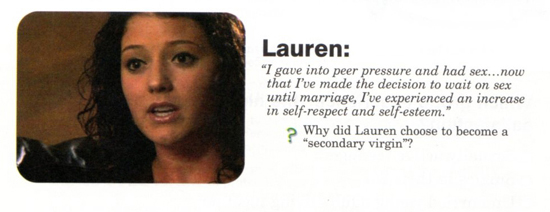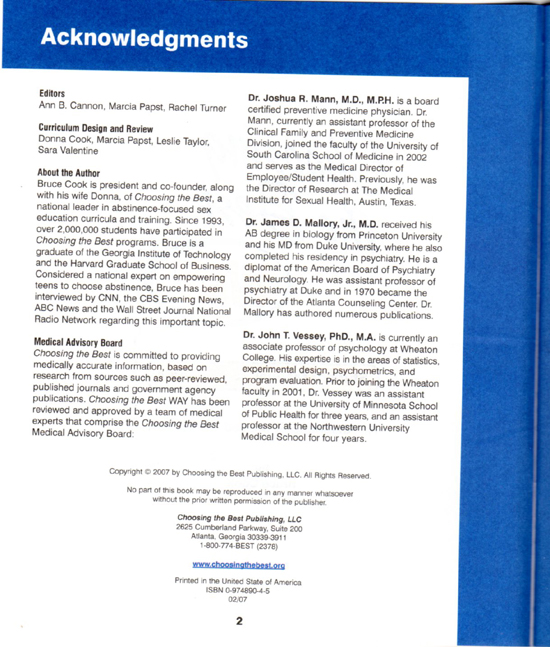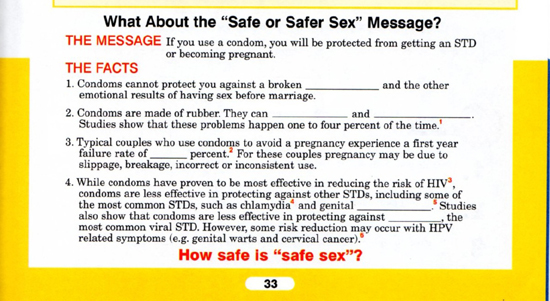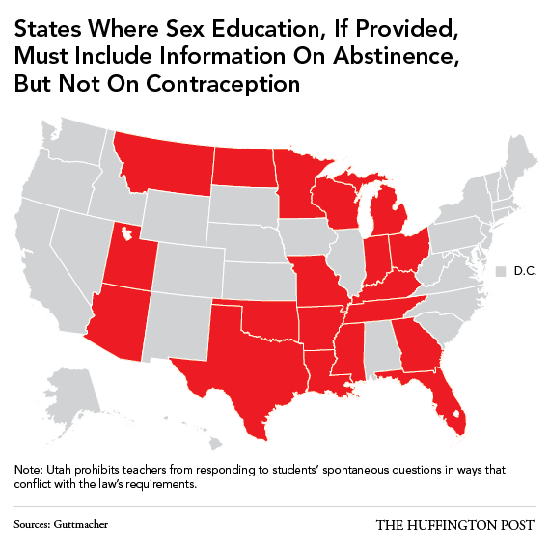“Sex is like pre-chewed chewing gum … Is that what you want to present to your husband?”
What does your kid’s sex education look like?
Choosing the Best is a company that claims to be the leader in abstinence-only sex education. Choosing the Best is based out of Atlanta, Georgia and run by Bruce and Donna Cook. CTB materials are used in 15 states and are part of the $1.5 billion in spending on abstinence training over the past 25 years.
Choosing the Best WAY is the curriculum designed for 6th graders to:
give students age-appropriate insight into what’s happening to their changing bodies and emotions, explores their new interest in the opposite sex, and teaches abstinence as the best WAY
I was introduced to Choosing the Best WAY through a presentation by Jim Helton about its use in the school his kids attend in Northern Kentucky.
Most of the CTB curriculum is based on fear and shame and, according to studies, doesn’t increase rates of sexual abstinence, the entire purpose of the program.
Here’s what this program looks like from the Choosing the Best WAY Student Manual.
Lesson 4 asks students to circle the possible emotional effects that a young teenager who becomes sexually active might feel.
Apparently, the only emotional effects listed that teens might feel are negative. There is never any sense that sex might be anything other than horrible.
Sex = bad.
As John Oliver said in a recent piece, I’m not even sure why they present it as a “choice”. There’s no “choosing” of the best way. They’re going to tell you. Sex is bad, kids.
No mention that their hormones might be telling them something completely different. No talk about how it’s too early, but eventually sex is a completely normal part of life. Just guilt, depression, and disappointment.
The curricula then features a few videos of kids talking about these apparent emotional effects.
Alicia says:
Abstinence is important to me … (premarital) sex is like pre-chewed chewing gum … is that what you want to present to your husband?
The book then asks: “What does Alicia mean by the example of ‘pre-chewed’ chewing gum?”
Of course, if you’re a woman, don’t worry too much if you turn out like pre-chewed chewing gum. You can always become a renewed virgin like Lauren.
Lesson 5 introduces the supposed benefits of waiting.
Of course, you might be completely incompatible in the sack and have to spend several miserable years together before working up the courage for a divorce.
It’s also not quite clear what “None” as an option even means. Does this mean you might trust each other “none”? Or does this mean there’s no difference between getting married after being abstinent and getting married after having premarital sex.
Most importantly though, I’m not sure how trust, respect, and success have anything to do with abstinence or if there’s any actual evidence that abstinence somehow increases any of these things. This seems to me like taking some things that some religions may think are true and putting them together under the guise of an “academic course”.
And maybe this couple wouldn’t have STDs if someone had taught them how to use condoms.
Who put this book together?
The author, Bruce Cook, graduated from Georgia Institute of Technology and the Harvard School of Business. He apparently knows nothing about sex education, but he’s managed to sell 2,000,000 copies of his book.
The book claims to have been reviewed for medical accuracy by a psychiatrist, a psychologist, and an assistant professor.
If you look at their claims about something as simple as condom use, however, they preach only a message of fear instead of a message that if you are having sex now or in the near future, you should use protection.
Answers: (1) heart; (2) break and slip off; (3) 15%; (4) genital herpes, HPV
The message above is quite misleading. Studies indicate that condoms, when used correctly, are 98-99% effective in stopping the spread of HIV. The rate of condom breakage or slippage is quite low, 0.4% – 2%, and even in these cases condom use reduces the risk of infection compared to unprotected sex.
The U.S. Centers for Disease Control and Prevention (CDC) states:
Latex condoms, when used consistently and correctly, are highly effective in preventing the sexual transmission of HIV, the virus that causes AIDS. In addition, consistent and correct use of latex condoms reduces the risk of other sexually transmitted diseases (STDs), including diseases transmitted by genital secretions, and to a lesser degree, genital ulcer diseases. Condom use may reduce the risk for genital human papillomavirus (HPV) infection and HPV-associated diseases, e.g., genital warts and cervical cancer.
The CDC also emphasizes that it’s important to note that the lack of data about the level of condom effectiveness indicates that more research is needed — not that latex condoms do not work.
You wouldn’t know this, however, from abstinence-only scare tactics and fear mongering. I have a hard time calling it “education”.
And if the failure rate of condoms in preventing pregnancy is due to incorrect use, shouldn’t we teach correct usage?
While there is some decent advice about setting boundaries and learning how to say “no,” some of the advice borders on the ridiculous and confusing.
The following shows a sandwich message for saying “no” which starts with “yes” and ends with “yes”.
I’m not sure, however, if “Let’s go grab a soda” worked even in 1952. Doesn’t seem much different than the terrible advice your grandmother might give you about sex – “Just tell him you’d like to go grab a soda, dear.”
Abstinence-only programs don’t work
In 2007, Mathematica Policy Research conducted a study on behalf of the U.S. Department of Health and Human Services. Four abstinence only programs were handpicked for the study to show positive results and the conclusions were still the following:
- There’s no evidence that abstinence-only programs increase the rate of sexual abstinence – the entire purpose of the programs.
- Students in these programs has a similar age of first sexual experience (14 years, 9 months) and numbers of sexual partners as their peers who were not in the programs.
- In 2003, Pennsylvania found that “taken as a whole, this initiative was largely ineffective in reducing sexual onset and promoting attitudes and skills consistent with sexual abstinence.” In addition, for those youth who are sexually active, reducing teen pregnancies, STDs, and HIV/AIDS requires alternative strategies.
- In 2004, Texas found no significant reductions and their analysis revealed that percentages of students reporting sexual intercourse actually increased between the ages of 13 and 17.
- Minnesota’s evaluation found that sexual activity doubled among junior high school participants in their Education Now and Babies Later (ENABL) program.
State studies have produced similar results:
States like Texas and Mississippi that have abstinence only programs also have the highest rate of teen pregnancies.
In addition, studies on virginity pledges have found that young people who took a pledge were one-third less likely to use contraception when they did become sexually active. In other words, pledges undermine contraception use.
In communities where there are a higher number of pledgers, overall STD rates were significantly higher than in other settings. Specifically, in communities where more than 20% of young adults had taken virginity pledges, STD rates were 8.9% compared to 5.5% with communities with few pledgers.
It’s 2015. We’re not supposed to be having outbreaks of chlamydia in high school like Texas.
The solution
There’s two things we can learn from our experiences with both abstinence only and comprehensive sex education programs.
One, we’ve paid over $1.5 billion since the 80s on programs that don’t do what they’re intended to do and have negative side effects on the health of kids.
Two, comprehensive sex education would be a much more effective and scientifically accurate method of teaching kids about sex. In Emerging Answers 2007, the largest study done to date on effectiveness of comprehensive sex education programs, 2/3 of the curricula were found to delay the initiation of sex and/or increase the use of condoms and contraception.
Comprehensive sex education programs include abstinence as the safest option but also encourage condom and contraceptive use and do all of this in a way that is more positive than fear-based and focused on shaming.
If we care about education, we should focus on what works.
The good news is that if parents step up, get involved, and talk to their school districts about what they are teaching, things can change. Jim Helton, who introduced me to the Choosing the Best curricula, was able to influence the move to a more comprehensive sex education program in his kids’ school. The new program still includes information on abstinence, but expands to include information about how to use contraceptives.
We can also work to pass laws to ensure sex education is medically accurate. Currently, only 19 states require sex education to be medically accurate.
When we know we have comprehensive sex education programs that work, why would we continue to spend on abstinence-only programs that don’t?
—
 |
David Akadjian is the author of The Little Book of Revolution: A Distributive Strategy for Democracy. Follow @akadjian |



